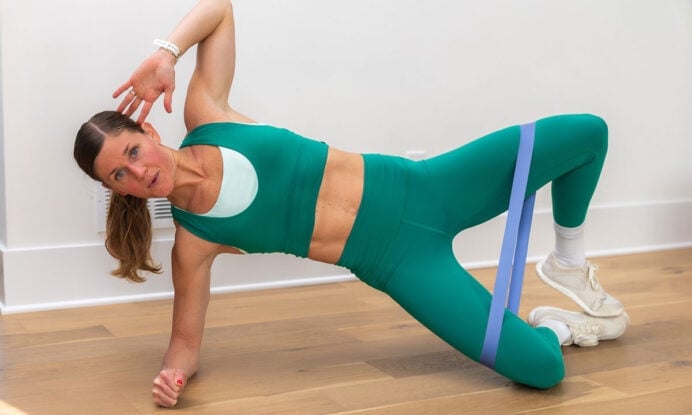
10-Minute Glute Activation Workout (With Mini Band)
Activate the muscles in the legs and butt with these glute activation exercises. Use this guided, 10-minute glute activation workout as a warm-up before your next leg day or run.
If you’ve ever done a lower-body strength training workout and have felt like your quads are doing the work but your glutes aren’t really engaged – you’re in need of some glute activation exercises.
Weak, inactive glutes are often a result of sitting all day and can lead to poor form, particularly in exercises like squats. If your knees are caving in or you struggle with range of motion in your squats, you should activate your glutes before your workout. Incorporating inner thigh work alongside glute activation can contribute to even greater stability and balanced lower-body strength.
Glute activation is important because we have several big muscles in our lower body, like the quads and hamstrings. Often, these muscle groups overpower the glutes and thighs, which can lead to muscle imbalances, low back pain and injury.
Muscle activation exercises are particularly beneficial for those who struggle with tight hips or lower back pain during and/or after leg circuits. They’re also great if you have a hard time feeling your glutes “turn on” during lower body exercises.
Glute muscle activation is all about making that mind-muscle connection. You need to consciously focus on squeezing and engaging your glute muscles during specific glute exercises. When you think about actively contracting those muscles as you perform the exercises, you’ll make that connection. Sometimes, using resistance like a mini band can really help you feel those muscles working.
That’s why I love these standing glute exercises. Some of my favorite banded glute activation exercises are squats, hip hinges and monster walks. Hip thrusts, step-ups, glute bridges, clamshells, donkey kicks and fire hydrants are other great glute activation exercises. These exercises are low-impact and great for beginners.
Benefits of Glute Activation Exercises
- Improve muscle engagement: You’ll use your glutes during lifts, rather than relying on your quads or hamstrings.
- Enhance stability: Strong glutes contribute to better hip and knee stability, which can improve your overall form and reduce the risk of injury.
- Lift heavier: When your glutes are properly engaged, you may be able to lift heavier during some leg exercises.
- Improve performance in other activities: Glutes are key for power during exercises like running and jumping.
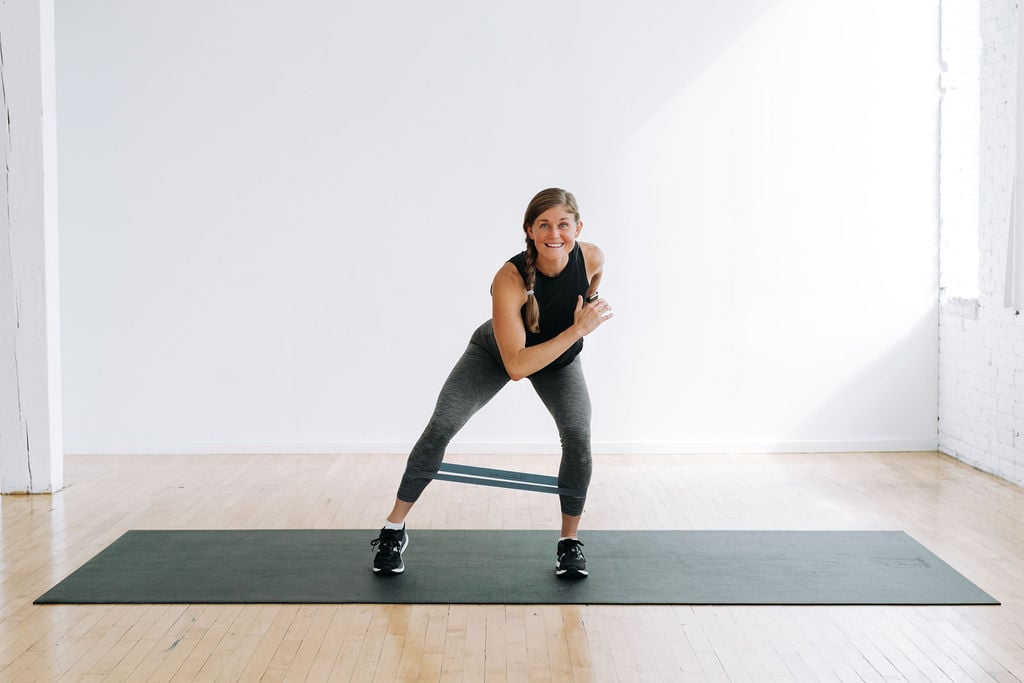
Workout Details
Fire up the glutes before your next leg workout or run with my favorite glute activation exercises.
You can do these glute activation exercises daily, especially if you feel like your glutes need some extra attention. However, you can also use these exercises as a glute warm-up before your leg day.
I usually aim for 5-10 minutes of glute activation work before lifting weights. The goal is to get those glutes firing and ready to work, not to fatigue them before your main workout.
Workout Equipment:
Mini Loop Resistance Band (discount code: NML). I’m using a light-to-medium resistance band in this workout.
Workout Instructions:
Follow along with the guided Glute Activation Workout Video on YouTube, led by me — your certified personal trainer, Lindsey Bomgren.
Your Workout Looks Like This:
- 8 Glute Activation Exercises
- Timed Intervals (40 seconds of work, 20 seconds rest; complete as many reps as you can in the timed interval)
- Complete all exercises x1 set
Workout Outline
Screenshot or Pin this Workout:
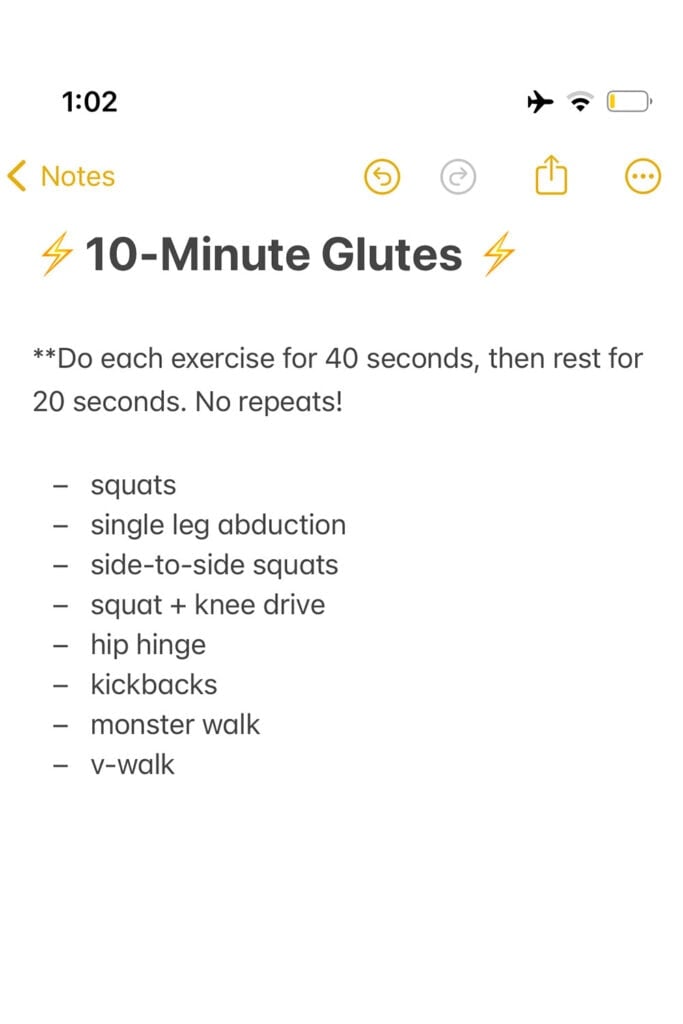
1. Banded Squats
Targets: Gluteus medius, hip abductors and quadriceps.
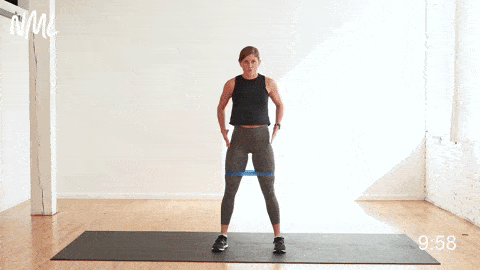
How to Do a Banded Squat
- Place a resistance band on your thighs, approximately 6 inches above the knees. Stand with your feet slightly wider than your hips to create tension across the band (activating your glutes).
- Sit back into a squat, lowering your hips until they are parallel to the knees. Strive for a 90-degree angle. Drop your hips down, keeping your weight in your heels and your chest up.
- Drive through your heels to return to a standing position. Squeeze your glutes at the top.
2. Banded Single Leg Hip Abduction
Targets: Hip abductor muscles including the gluteus medius, gluteus minimus and tensor fasciae latae (TFL).
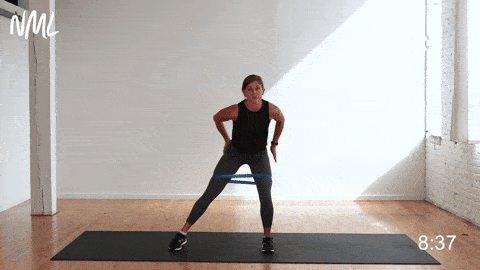
How to Do a Banded Single-Leg Hip Abduction
- Place the resistance band on your thighs, approximately 6 inches above the knees. Stand with your feet slightly wider than your hips to create tension across the band (activating your glutes).
- With your knees bent, place 80% of your bodyweight on your right leg and 20% on your left foot.
- Step your left leg out, driving through the left glute to stretch the band as far as you can. Tap your left foot to the side.
- Step your left foot back into center, keeping your feet slightly wider than your hips to keep tension across the band.
- Repeat this sequence, balancing on your right leg while stepping the left foot out and back in for the timed interval.
3. Banded Side-to-Side Squats
Targets: Gluteus medius, hip abductors and quadriceps.
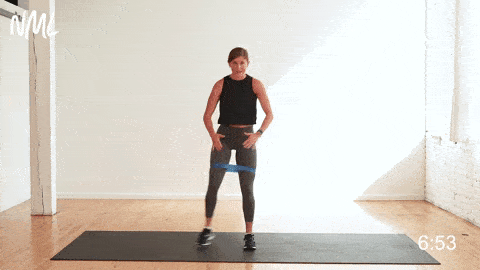
How to Do a Banded Side-to-Side Squat
- Place the resistance band on your thighs, approximately 6 inches above the knees. Stand with your feet slightly wider than your hips to create tension across the band.
- Step your right foot out, stretching the band as far as you can.
- As you step out, sit back into a squat, lowering your hips parallel to your knees. Drop your hips down, keeping your weight in your heels and your chest up.
- Hold this squat position for a moment, then drive through your heels and step back to center, returning to a standing position.
4. Banded Squat And Knee Drive
Targets: Gluteus medius, hip abductors, quadriceps, hips and hip flexors.
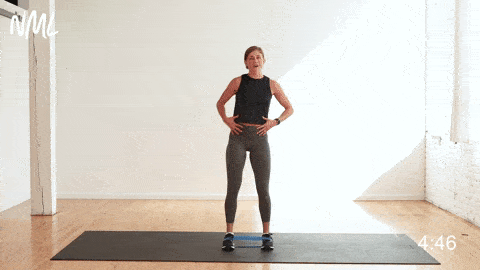
How to Do a Banded Squat and Knee Drive
- Loop the resistance band around the arches of both feet (around the soles of your shoes). Begin standing with feet shoulder-width apart.
- Step your left foot out wide, stretching the band as far as you can. As you step out, sit back into a squat, lowering your hips parallel to your knees.
- Hold this loaded squat position as you step your left foot in slightly. You should now be in a narrow squat position. Tension is still in the band.
- As you drive through the right heel to stand tall, perform a knee drive with the left leg. Drive your left knee up, activating the hip flexor to stretch the band as far as you can (until your left knee is in line with the left hip).
- Lower your left leg back down to return to the starting position.
5. Banded Hip Hinge (Deadlift)
Targets: Hip extension, gluteus maximus, hamstring muscles and lower back muscles.
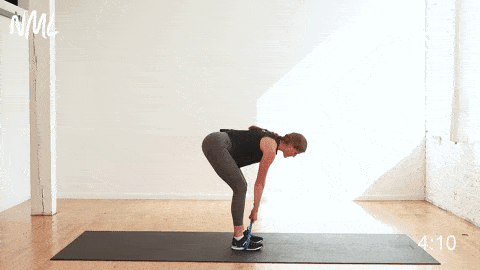
How to Do a Banded Hip Hinge (Deadlift)
- Loop the resistance band around the arches of both feet. Begin standing with your feet hip-width apart.
- Grab the top of the band with both hands and stand up, stretching the band.
- With a soft bend in your knees, hinge at your hips to slide your hands down the front of your legs. Think about pushing your hips back behind you like you would for a deadlift.
- Hinge until you feel a stretch in the back of your legs (hamstring muscles).
- Then drive through your heels to stand up, pulling the band to create tension.
6. Banded Kickbacks (Glute Kickbacks or Donkey Kicks)
Targets: All three gluteal muscles — the gluteus maximus, medius and minimus, as well as the hamstrings, spine and back (entire posterior chain or backside of body).
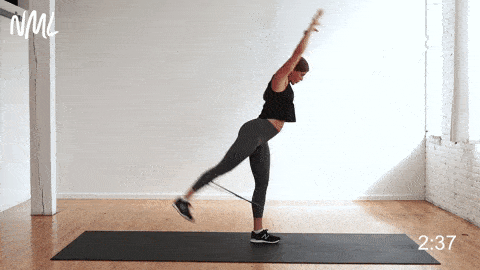
How to Do a Banded Kickback (Glute Kickback or Donkey Kick)
- Place the resistance band around the shin/calf area, approximately 6 inches below the knees. Begin standing feet hip-width apart, slight bend in the knees.
- Sit back into a narrow squat, lowering your hips parallel to your knees.
- Drive through your heels to stand tall. As you do so, perform a leg lift by kicking your right leg back behind you, stretching the band as far as you can. Drive your arms overhead to increase engagement along the entire backside of the body.
- Bring your right leg back to center and sit back into a narrow squat.
- As you drive through your heels to stand tall again, kick your left leg back behind you, stretching the band as far as you can. Drive your arms overhead.
- Repeat this sequence for the timed interval, alternating the leg that kicks back.
7. Banded Monster Walk (Frontal Plane)
Targets: Gluteus medius and hips.
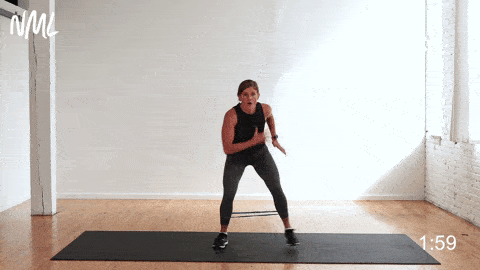
How to Do a Banded Monster Walk
- Place the resistance band on the shin/calf area, approximately 6 inches below the knees. Stand with your feet slightly wider than your hips to create tension across the band.
- Bend at the knees to find a loaded squat position.
- Step your right foot out wide to stretch the band and create tension.
- Step your left foot out wide to stretch the band and create more tension.
- Step your right foot in, then step your left foot in to find a loaded narrow squat position. Think, “wide, wide, narrow, narrow.”
8. Banded Monster Walk Or V-Walk (Sagittal Plane)
Targets: Hips, hip flexors, gluteus medius, quads and hamstrings.

How to Do a Banded Monster Walk or V-Walk (Sagittal Plane)
- Place the resistance band on the shin/calf area, approximately 6 inches below the knees. Stand with your feet slightly wider than your hips to create tension across the band.
- Bend at the knees to find a loaded squat position.
- Take a step forward, stepping your right foot out wide in front of you to stretch the band and create tension.
- Take another step forward, stepping your left foot out wide to stretch the band and create more tension.
- Take another step forward with your right foot and another step forward with your left foot, keeping constant tension on the band.
- Then, reverse your direction by taking steps back. Step wide each time, keeping constant tension on the band. Think of stepping as wide as your yoga mat.
FAQs
The “8-8-8 rule” for glutes refers to a glute workout routine that includes 8 sets of 8 different exercises and focuses on 8 weeks of training. This format should include a variety of glute exercises. A workout routine like this should be maintained for at least 8 weeks to allow for progress and muscular hypertrophy.
If you’re not feeling glute activation exercises in your glutes, it could be that you have tight hip flexors or that other muscle groups are overcompensating during exercise. This is often due to a lack of mind-muscle connection. It’s also possible that you’re not performing exercises correctly or using the appropriate resistance.
If you experience low back pain, knee pain or hip pain, you may have weak glutes. An altered gait, balance problems and difficulty with certain exercises like squatting can also be signs of weak glute muscles. Add glute activation exercises and lunge or squat alternatives to your routine to build strength.
If you notice that your quads fire up instead of your glutes, you should practice some simple strength exercises to get the glutes firing. Lie on your side with your back against the wall. Press the heel of your foot into the wall and raise your leg, drawing small half circles up and down the wall with your heel. This should get the glute firing and engaged. Placing the resistance band around the soles of your shoes (bottom of feet) and doing side-to-side walks is a great way to get the glutes firing as well.
More Workouts
Lower Body WorkoutsPin This Glute Activation Workout
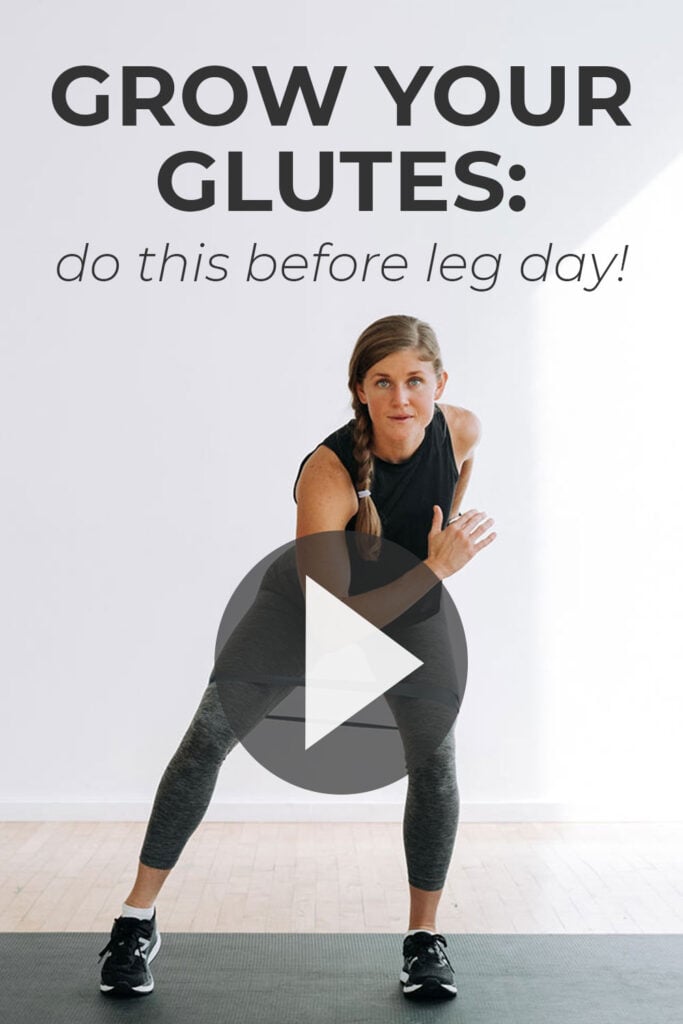
This post includes affiliate links. I do make a small commission for products purchased using these links (at no additional cost to you). Thank you for supporting Nourish Move Love, making the content you see on this blog possible.










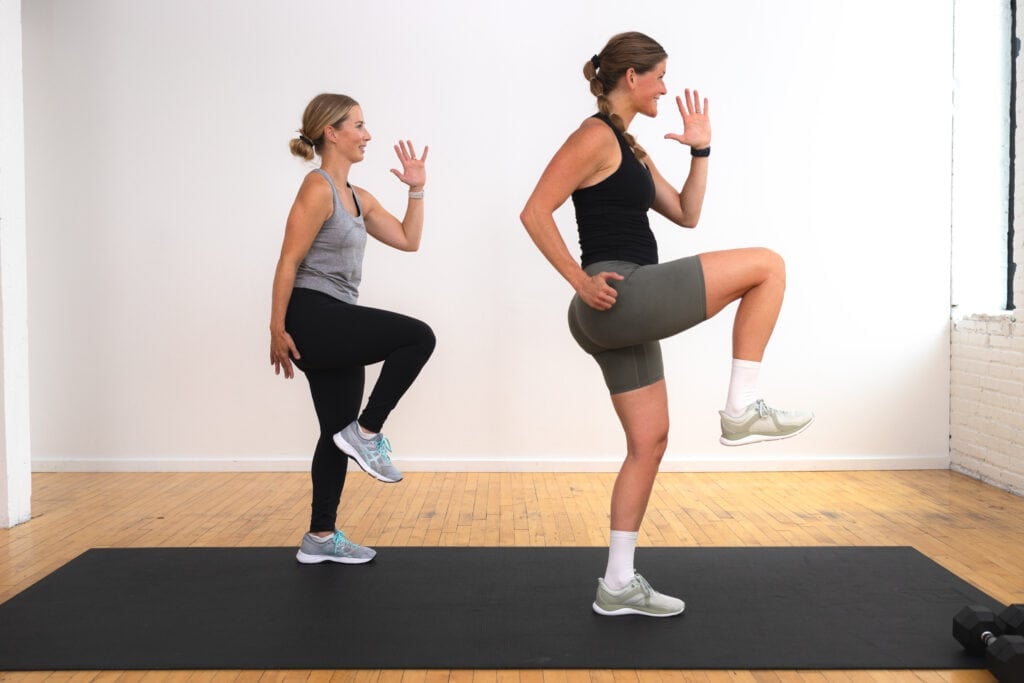
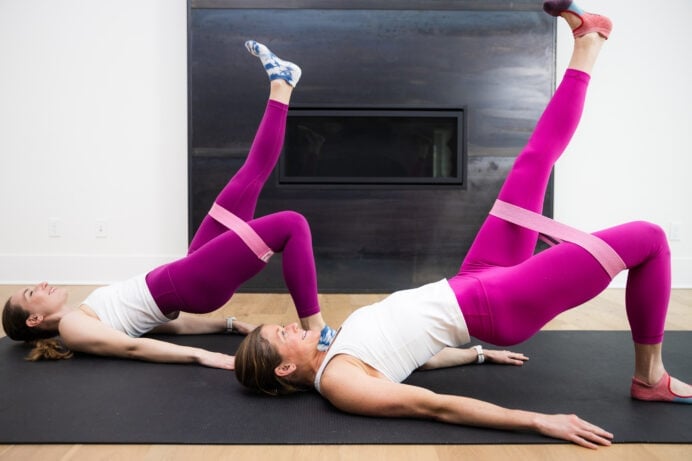

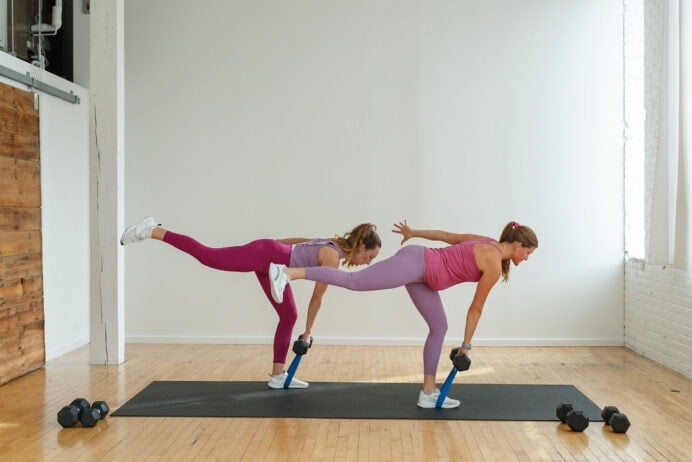
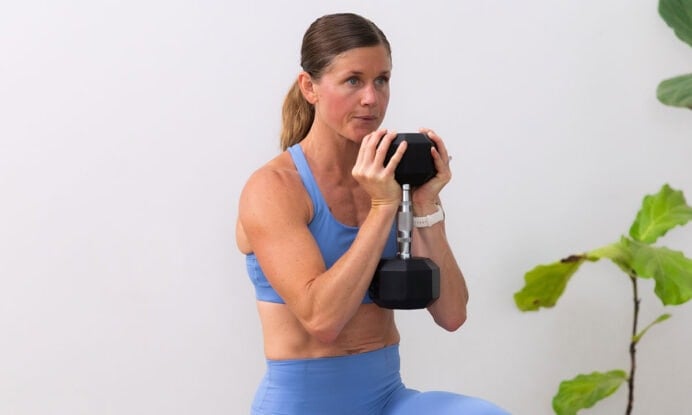

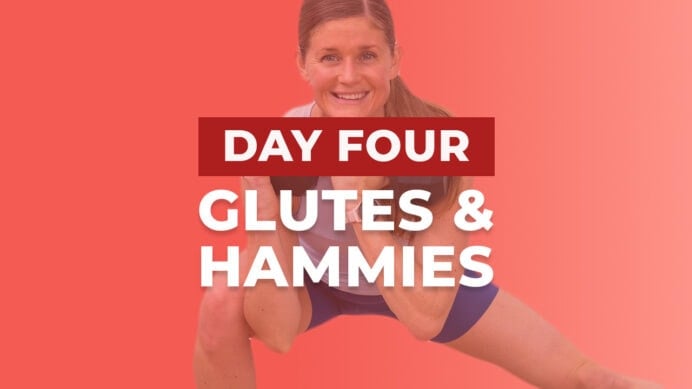
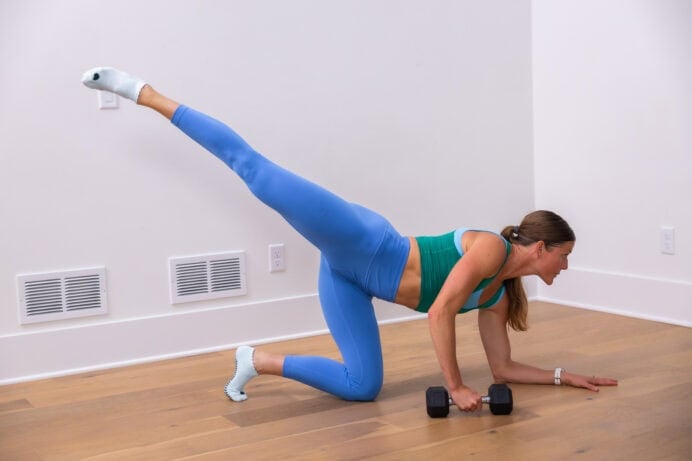
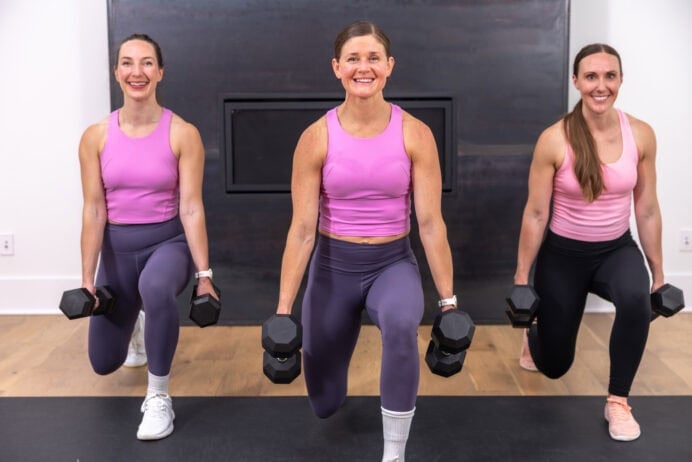

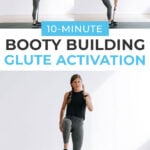






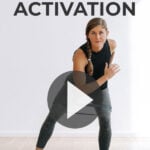
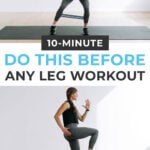



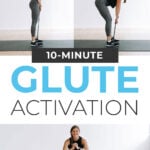

Hi, my quads turn on instead of my glute (one leg only) when I try to do many of these exercises. I am trying to get glute activation working to stop chronic knee pain (same one leg) when running. Whats your advice for approaching these exercises and getting the quad to switch off? Annie
Hi Annie! Great question I would start with a simple glute activation exercise first to get the glutes firing — lie on your side with your back against the wall (glute that’s having trouble firing up), from there press the heel of your foot into the wall and raise your leg drawing small half circles up and down the wall with your heel. This should get that glute firing. Once you have the glute active then start this routine! Also placing the resistance band around the soles of your shoes (bottom of feet) and doing side to side walks is a great way to get those glutes firing (band around feet vs thighs). I hope that helps! -Lindsey
Love this thanks!
Ira! So glad you loved this mini band glute activation workout! Thanks for giving it a try, and I hope you come back for more! -Lindsey